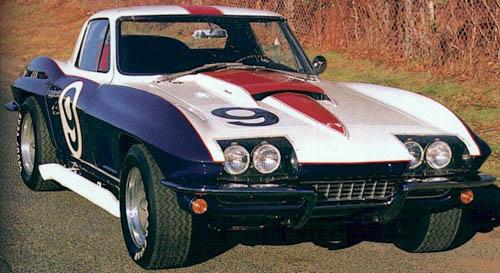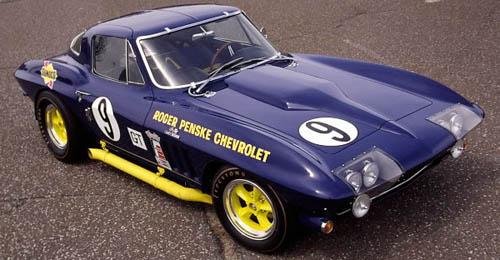|
1967 Chevrolet Corvette L88 Sunray DX
At Sebring in 1967, the Corvette L88 made its debut appearance. The
L88 package included many competition components which included a M22 transmission, large disc brakes, upgraded suspension
and an alumunim head 427. Shortly after the race, the L88 option would be offered on production cars which was a tormedous
package for a road-going machine. It offered the most powerfull engine that would ever appear in a production Corvette.
The
engine itself had numerious special components: a new forged crank, 12.5:1 pistons, cold air induction and alloy cylinder
heads.
Other changes to the car included a complete removal of all luxuries. Chevrolet removed heater, radio, air
conditioning and choke. To compensate for these deletions, an F41 suspension, K66 ignition transistor, J56 power discs, G81
positraction differential and a large aluminum radiator were added.
L88 was a race car and Chevrolet wanted to keep
it on the track. If the deletion of several creature comforts wasn't enough, the advertising for the car rated the L88 as
having less horsepower than the cheaper L71 package. Chevrolet released a figure of 430hp at 4600 rpm. This was well below
the actual peak power which was 600 hp at 6500 rpm.
The Sunray DX L88 is an important car because it was one of the
first L88s made. It was also one of only 20 L88 corvettes made that year. Don Yenko helped convince Chevrolet to build the
L88 package specifically so the DX Sunray team could go racing at Sebring. The car's oustanding achievement was a first in
class at Daytona in 1968. That race, the car even outpaced the 1968 Stingray L88s.
This spectacular example was recently
offered for public sale by RM Auctions. Having undergone a complete restoration that brought that car back to its 1967 configuration
the car was the most impressive Corvette at the sale. The car recieved a high bid of $900 000 USD but did not reach the reserve
price.

1967 Chevrolet Corvette Le Mans Racer
Dick Guldstrand, Bob Bondurant, and Dick Yenko took this 1967 Corvette coupe with an L-88 427 ci engine to
the 24 Hours of Le Mans. Dick Guldstrand set a new record speed of 171.5 mph on the Mulsanne straight. In the 13th hour,
the engine failed, ending the race for the lone Corvette. This is the only mid-year (1963-67) Corvette to have ever
competed in the 24hrs of Le Mans.
More Pictures & Info
VIDEO: Victory By Design - L88

1966 Roger Penske L-88 Corvette
In 1966, Chevrolet Central Office authorized this C.O.P.O. (Central Office Production Order) Corvette to be built with
the first factory 427 L-88 engine and the competition race package which included J-56 brakes, 36 gallon fuel tank, F-41 suspension,
prototype 2:73 positraction rear axle, TI ignition, M-22 transmission, off road exhaust, radio and heater delete, teakwood
steering wheel, telescopic column and a special prototype cowl induction hood.
The car was released to Roger Penske who had worked in Chevrolet's race program since pre-Grand Sport Days. Penske wanted
the racer prepared for the 24 hour Endurance Race at Daytona. He based on Zora Duntov's recommendation, hired Dick Guldstrand
to assemble a team for the Daytona race.
Penske's Newtown Square Garage then prepared the car for the Daytona Race. In practice laps the Factory L-88 was one
of the quickest ever recorded at Daytona. Chevrolet sent a second engine to Traco to be prepared, and just before the race
the fresh 540 h.p. motor was installed in the car.
Penske assembled the experienced team of Dick Guldstand, Ben Moore and George Wintersteen for the race. During the race,
Wintersteen was involved in an accident damaging the front of the car, thus requiring Guldstrand to drive his portion of the
race with two flashlights taped to the fenders. The damaged radiator was replaced with one from a Corvette located in the
spectator's parking lot. One can only imagine, the flashlights provided very little help! Guldstand was able to continue the
race by following the taillights of the Ferrari Team Car and by doing so broke the GT record. The L-88 finished 1st. in the
GT Class and placed 11th overall in the race.
The car was raced at Daytona in its original factory red paint, after which, at the request of its sponsor it was painted
Sunoco blue for the next race at Sebring. With its fresh blue paint job, the car was raced at the 12 Hours of Sebring where
it finished 1st in class, and 9th overall, tying the record as the highest finish ever for a Corvette. What a history making
record the car was setting for itself in only two times out!
The #9 racer has been featured on the cover of Corvette News Vol. 9 No. 5. It is nationally recognized as one of the
of the most important Corvette's ever manufactured. This car represents the first acknowledged L-88 Corvette and the only
"mid-year" to win first in class consecutively at Daytona and Sebring.
This car has a prototype hood. One of Three
made by GM. The other two went on the Corvette Grand Sports. This one was installed at the factory.
More Pictures & Info
|

